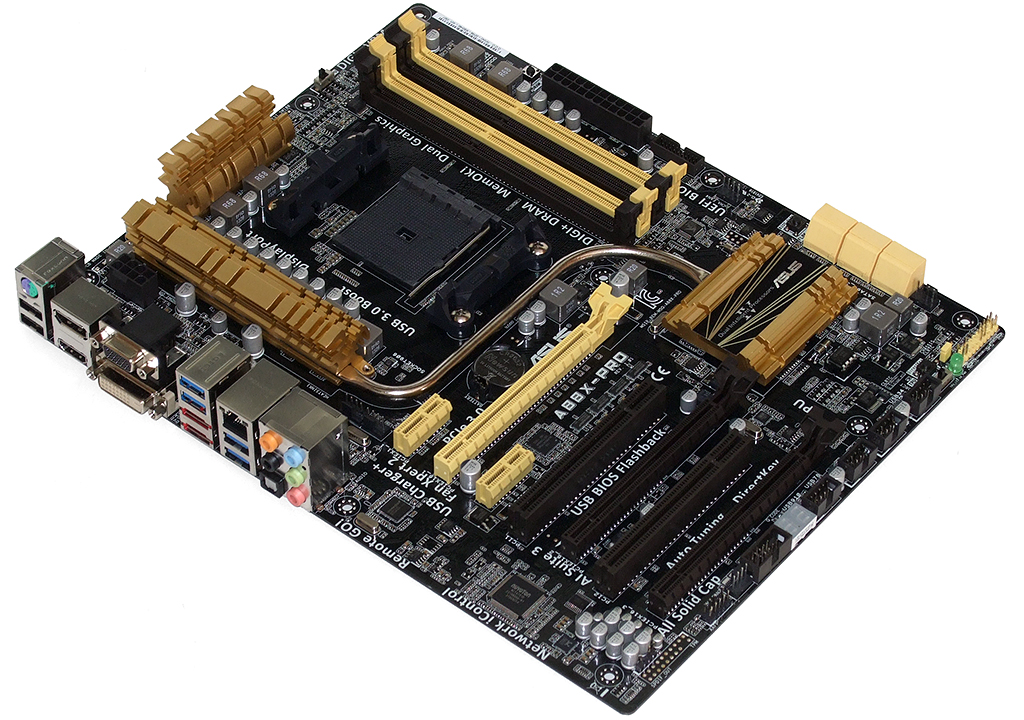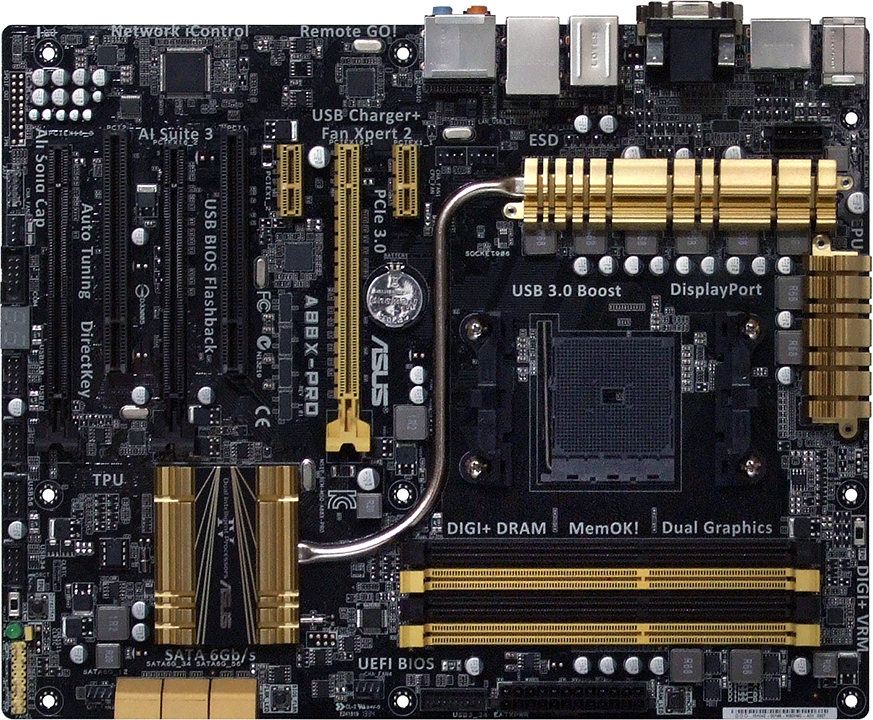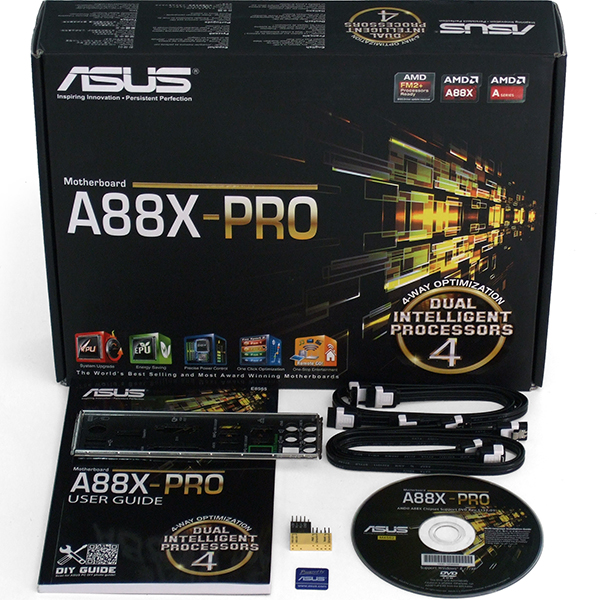Which A88X-Based Board Should You Buy For Your Kaveri APU?
Asus A88X-Pro
We don't give out awards for concise and easy-to-remember names, but we certainly appreciate Asus’ effort to keep nomenclature simple. Big on features, the A88X-Pro adds DisplayPort, eSATA, a Port 80 diagnostics display, USB BIOS Flashback, and a larger CPU voltage regulator for around $5 compared to ASRock's competing platform.
That’s a pretty long feature list for such a small bump up in price, but realistically, the added cost for some new functionality is low. The eSATA ports, for example, come from the A88X FCH's SATA 6Gb/s controller, and they only benefit builders who need no more than six internal 6 Gb/s connectors.
The A88X-Pro’s Realtek-supplied GbE controller is cheaper than the Qualcomm Atheros Killer E2205 on ASRock's platform, but Asus' feature advantage doesn't stop with the already-mentioned list. Enthusiasts who want to add multiple graphics cards will find that the A88X-Pro has three PCIe x16 slots, including the four-lane slot exposed by ASRock. The middle interface on this particular board is fed by eight lanes from the top slot, via four dual-lane PCIe switches.
Only one of the PCIe x1 slots will be available to power users adding discrete graphics on top of AMD's integrated Radeon engine, since the dual-slot coolers found on most performance-oriented cards block the second x1 link. On the other hand, if you go the three-card route, you'll still have access to a legacy PCI slot in the middle of the board, in addition to the top x1 slot. Mainstream APUs and multi-card graphics arrays are far from balanced in a gaming machine, but they could be a realistic option for anyone who needs a lot of compute potential for, say, a cryptocurrency mining rig.
The A88X-Pro’s layout is nearly perfect for every case I’ve tested, owing to the USB 3.0 header mounted above card slots and front-panel audio header slid around an inch forward from its traditional bottom-rear corner. That last part remains unbelievably important, since we’re still finding new cases with FP-Audio cables around half of an inch too short.
Without any good reason to criticize this layout, I can still point to Asus’ non-standard front-panel I/O header as the reason why case manufacturers haven’t been able to unify that bundle of leads.
Asus’ A88X-Pro includes four SATA cables, or twice as many found in ASRock's bundle. We also find a couple of header extensions, which can be used to bundle loose front-panel cable ends together prior to connecting the board. These wouldn't be necessary if everyone used the same layout, but they're still handy in today's non-unified world.
Get Tom's Hardware's best news and in-depth reviews, straight to your inbox.
-
gadgety To me the point of Kaveri is great graphics in a small package, thus the MB would have to be as small as possible. M-ITX is currently the smallest. Someone should bring out a NUC sized board for the Kaveri.Reply -
blackmagnum On the other side of the fence... Haswell+ Maxwell= performance/watt/buck. You're welcome.Reply -
ta152h The IO device is called PS/2, not P/S 2. It stands for Personal System/2, the IBM product line from 1987. Also, there's a chance there's a big performance gain from Catalyst 14.2, instead of 14.1. Another site did benchmarks comparing 13.6 and 14.2, and the difference was dramatic. It most likely was the somewhere in the 13.6 to 14.1 range, though. I thought the days of one motherboard having significantly faster memory timings than the other died with the IMCs. After being shocked at the horrible performance of the Kaveri, and the almost complete failure of it, between the driver update, and advantage the Asus has, it's clear AMD pulled another "Hawaii", and put their technology in the worst possible light by not packaging it with the proper associated support technologies. Considering the long development cycles for these devices, it's hard to understand how AMD couldn't figure out a proper cooler for the Hawaii, or have drivers degrade performance so much for Kaveri, that within a month or so they were able to increase performance so dramatically. And now, it's clear the memory performance optimizations were far from complete. And Kaveri was a delayed product. It boggles the mind that they consistently fail to find such obvious shortcomings, when everyone else finds them pretty quickly. Clearly, their testing procedures need serious revision in scope.Reply -
ferooxidan "To me the point of Kaveri is great graphics in a small package, thus the MB would have to be as small as possible. M-ITX is currently the smallest. Someone should bring out a NUC sized board for the Kaveri."No, the best NUC will be Haswell + Maxwell, period.Reply -
almarcy Thank you for a useful grid of the current products. I am migrating from my current dinosaur. I am not at all interested in smaller, sleeker, tighter. Just faster. ~4 GHz with 2.4 GHz DDR3 for under $500. seems pretty irresistible :)Reply -
Someone Somewhere Can we see some benchmarks on the Killer card vs other competitors? It feels like FUD to me.Reply -
beerdette "No, the best NUC will be Haswell + Maxwell, period."The point of Kaveri on a NUC would be not to have the space that a graphics card takes. So it wouldn't be the best NUC because then you need to add space for that card.Reply -
de5_Roy Reply
yes. but at a lower price range probably. first, a10 7850k itself has to come down in price by $40-50 outside microcenter.12925440 said:Is anyone actually going to buy an ATX Kaveri motherboard?
-
vertexx Reply12925643 said:
yes. but at a lower price range probably. first, a10 7850k itself has to come down in price by $40-50 outside microcenter.12925440 said:Is anyone actually going to buy an ATX Kaveri motherboard?
Even beyond price, ATX seems pointless with a Kaveri APU. Myself, I'm waiting for the A8-7600 to build a very small (< 3 liters) ITX HTPC running the APU in 45W mode. Although I'm very excited about doing that build, I can't see any use case that makes sense for a Kaveri APU in an ATX form factor. Perhaps the A88x chipset has some feature benefit for building something using the 750 or 760k CPU in a budget build. But the only build I would even think about using a Kaveri APU in would be a mini-ITX PC/HTPC or laptop.
Beyond that, I would love to see Lian-Li come out with a tiny case like the PC-Q02, PC-Q09 or PC-Q12, but with the design for a single 120mm CLC and a 300W SFX PSU to allow a decent overclock on a 7850k APU with the smallest form factor possible (i.e. < 8 liters). That type of build might get me jazzed up for the 7850k.



